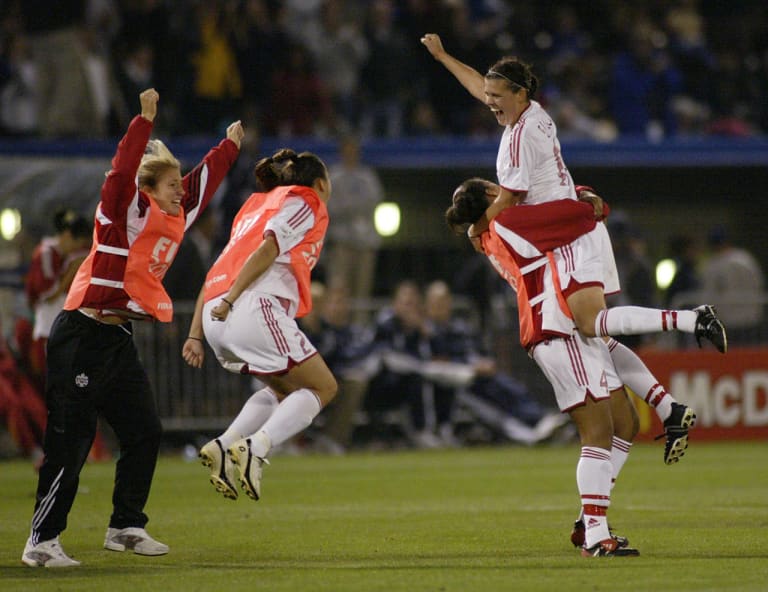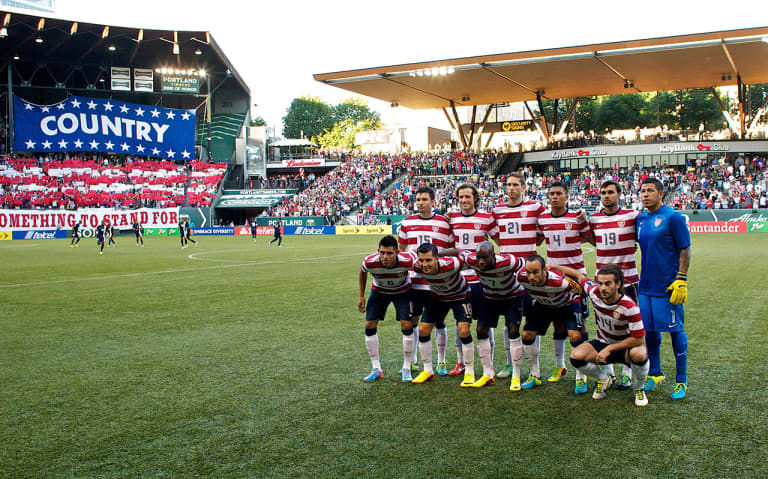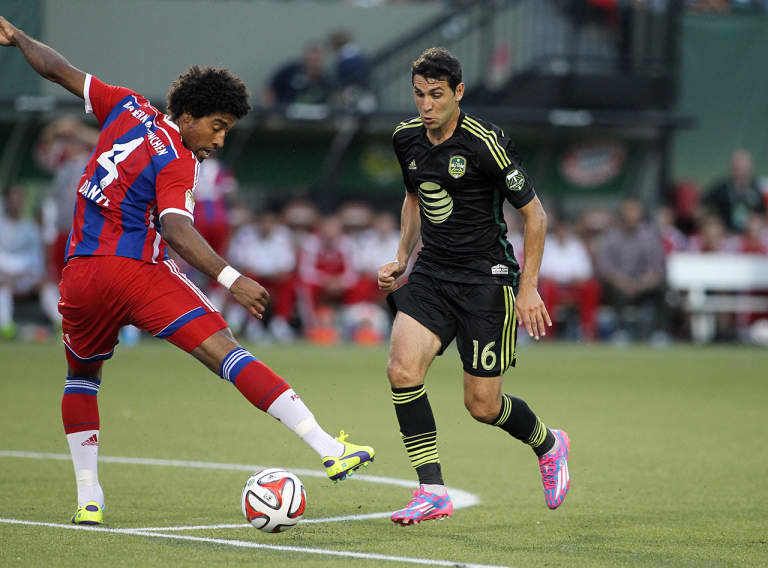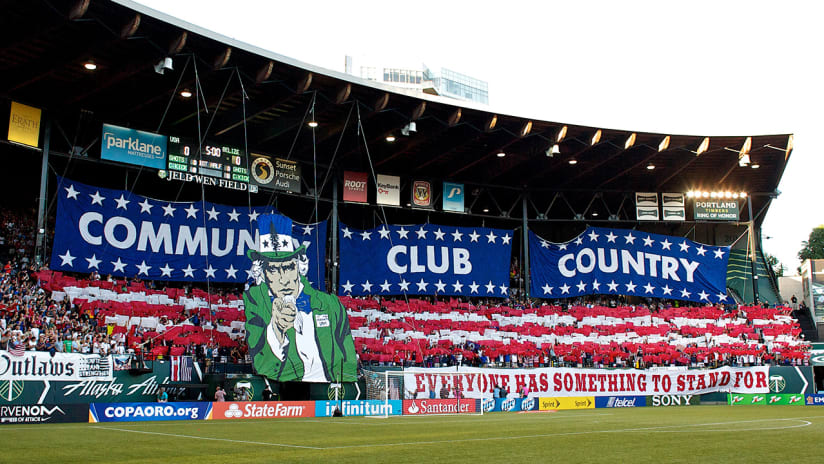Editor’s Note: This past October 9 marked 90 years since the venerable Providence Park hosted its first-ever event: a football game between the University of Oregon and Oregon State. Designed by A.E. Doyle—a ubiquitous Portland architect for his era who designed the downtown Multnomah County Library, the Meier & Frank Building (now The Nines Hotel) and much of Reed College, among others—Multnomah Stadium, as it was first called, was built as part of the neighboring Multnomah Athletic Club in 1926.
Before becoming an American soccer mecca, the stadium hosted countless sports and non-sporting events as well as undergoing a few name changes from Multnomah Stadium to Civic Stadium to PGE Park to JELD-WEN Field and finally to the current Providence Park. From ski jumping to greyhound racing to major college football, the stadium has become an icon in the Rose City.
- A Full 90 | 1926-World War II
- A Full 90 | Mid-twentieth century
- A Full 90 | The NASL era
- A Full 90 | The 1980s-2000
While soccer has emerged as its main event with the dawn of a new century, the beautiful game has made a home at the stadium throughout its 90-year history. Timbers.com has been examining the different soccer eras at Providence Park with this final chapter looking at the era from 2001 to the modern day.
-----------
While soccer has been played at Providence Park for just over 90 years, there is no debate that the current era presents the most celebrated presentation of the beautiful game. With the dawning of the new millennium, through two renovations (prior to the 2001 and 2011 Timbers seasons) and more than 325 matches, the stadium is now one of the global cathedrals of the sport.
In the time since the Timbers’ revival in 2001, and leap into Major League Soccer in 2011, the club has welcomed a variety of international opponents to the stadium for friendlies and competitive tournament matches—perhaps with no event bigger than the 2014 AT&T MLS All-Star Game. In addition, Providence Park (known as PGE Park from 2001-2010 and JELD-WEN Field from 2011-2013) developed into an internationally renowned epicenter of women’s soccer, hosting the 2003 FIFA Women’s World Cup and a first-of-its-kind 2002 WUSA All-Star Game, all before the formation of the NWSL and the launch of Portland Thorns FC—the best supported women’s pro team in the world in any sport.
“Basically, to see the passion that erupted within that first game was an inkling of what it is now but it was still a great insight into what the rivalry actually meant to both cities.”
–Timbers GM, then-defender, Gavin Wilkinson
Timbers.com
Following the end of the NASL and a semi-pro version in the late 1980s, the Portland Timbers returned to the stadium in 2001 against readymade rival Seattle Sounders in front of 12,295 as part of the United Soccer League. Portland won the game 2-0 and the season sparked a revival of soccer love in the then-named PGE Park. The era also marked the genesis of the Timbers Army as supporters of the club congregated in section 107 behind the North End goal.
It was a start of a golden age of soccer at the stadium.
"The response was impressive. It's not surprising. They knew the game of soccer. They enjoyed the game out there."
–Tony DiCicco, Commissioner of the WUSA, on the league’s all-star game held in Portland
The Oregonian, 2002
On Sept. 21, 2002, the first professional women’s soccer league in the U.S., the Women’s United Soccer Association (WUSA), held its first ever all-star game. And despite not having a team in Portland, the showcase for the best in the WUSA had one of its most successful editions in the Rose City.
A crowd of 14,208 watched the South defeat the North by a 6-1 scoreline. Former teammates at the University of Portland, Shannon MacMillan and Tiffeny Milbrett, served as team captains, while a rookie from the Washington Freedom took home MVP honors. Her name was Abby Wambach. She went on to become the most prolific goalscorer in the history of international soccer.
“Right now, this is the highlight of my career. This is the World Cup. This is what it's all about. And to be able to play the game in Portland, I can't even describe it. It's like I'm dreaming."
–Canada forward Christine Sinclair on playing in the Women’s World Cup
The Oregonian, 2003

(Action Images)
After the 2003 FIFA Women’s World Cup was moved from China to the United States due to a SARS outbreak, Portland was selected as one of six host cities for the event. The city had previously hosted four matches in the 1999 FIFA Women’s World Cup, but it was little comparison to the six matches played in Portland in 2003, including both semifinal matches.
On an autumn Sunday afternoon, a record crowd of 27,623 was in attendance to see Germany defeat the defending champion U.S. and Sweden beat Canada. Future Portland Thorns FC player Christine Sinclair, who was 20 years old at the time and redshirting at UP, started and played the full 90 minutes for the Canadians.
"I just couldn't stop smiling the whole night I was out there warming up and just laughing to myself."
–Timbers forward Dan Antoniuk on facing the EPL’s Sunderland AFC.
The Oregonian, 2005
Soccer continued to grow in the early part of the decade with the rise of the USL-era Timbers. With the club’s growth, came an overall rise in attendance with matches against regional rivals Seattle or Vancouver or key U.S. Open Cup battles that often pitted the club against teams from MLS, drawing even larger crowds. In 2005, Portland hosted newly promoted English Premier League side Sunderland AFC in a match that drew a then-Timbers record of 13,351.
Attendance continued to climb and in 2009, Portland was announced as the newest team to join Major League Soccer, as they were scheduled to launch in 2011. Renovations began on the then-named PGE Park to expand seating and prepare for the new league. The game’s growth was well on its way in Soccer City, USA.
“I loved it. I think most of us that play in MLS love coming here to play against this team because of the environment that’s created. Outside of LA, this is my favorite city in the U.S. and it was fun to play here with the home crowd.”
–Landon Donovan, leading scorer in U.S. Men’s National Team history, following a 6-1 U.S. victory over Belize in the 2013 Gold Cup
Timbers.com, 2013

(Photo by Craig Mitchelldyer)
When Portland joined MLS in 2011, the stadium environment became well-known throughout the world in part due to the vociferous Timbers Army and excellent game atmosphere. Along with world-class soccer from the Timbers, international friendlies against the likes of AFC Ajax from The Netherlands and Mexico’s Club America, the stadium was selected to host an international doubleheader during the group stages of the 2013 CONCACAF Gold Cup, including a return of the U.S. Men’s National Team. In the first match of the twin bill, Costa Rica knocked off Cuba 3-0, in a match that included then-Timbers player Rodney Wallace in the starting XI for Los Ticos.
In the late game, the U.S. easily handled Belize, defeating the Central American opposition 6-1. Donovan had two assists in the match, eclipsing the 50-assist mark for his international career and becoming the first American male to both score and assist on at least 50 international goals.
The game is also remembered for the impressive tifo display prior to the match that was a collaboration between the Timbers Army and the Portland chapter of the American Outlaws. The display featured a Cascadian Uncle Sam and the words “Community, Club, Country.” In fact, when MLS introduced a new logo for the league in 2014 that included three stars in the upper left corner of the crest, the tifo was credited as part of the inspiration.
"I thought it was a really fun game. Exciting. Our fans, everybody…they were tremendous. I thought they really added to the atmosphere and made it a wonderful night and a great celebration for our sport in this country, this league [and] Major League Soccer…."
–Caleb Porter, head coach of the Portland Timbers, after he managed MLS All-Stars to a 2-1 victory over Bayern Munich in the 2014 AT&T MLS All-Star Game.
Postgame Press Conference, 2014

(Photo by Craig Mitchelldyer)
In the summer of 2014, Providence Park played host to German footballing legends FC Bayern Munich as the Bundesliga champions took on the MLS All-Stars. Coached by Porter, the MLS side used two second-half goals to defeat Bayern in a hard-fought match. Timbers hero Diego Valeri delivered the game-winning assist when he set up Donovan for a goal. Bayern featured six players who had won the 2014 FIFA World Cup with Germany only a month before the game. The match also marked the first time the same venue as having hosted both a men’s and women’s professional soccer all-star game.
After 90 years of early area club matches, international battles, high school games, the arrival of the Timbers, meteoric growth of the women’s game and much more, Providence Park has been a veritable mecca for the rise of soccer in America.
What will the next 90 years bring?












